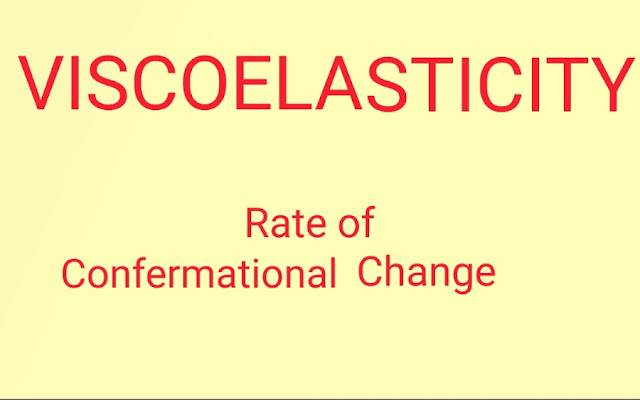VISCOELASTICITY FOR RATE OF CONFORMATIONAL CHANGE
VISCOELASTICITY
As mentioned at the outset of this chapter, some materials exhibit a combination of enthalpic and entropic mechanical response. “Viscoelastic” polymers are an example, in which an immediate and recoverable response due to bond distortion can take place, but also accompanied by an entropic response due to conformational change.
While not all polymers are viscoelastic to any important practical extent, and even fewer are linearly viscoelastic^3, the linear theory provides a usable engineering approximation for many ap-plications in polymer and composites engineering. Even in instances requiring more elaborate treatments, the linear viscoelastic theory is a useful starting point.
Rate of Conformational Change
When subjected to an applied stress, polymers may deform by either or both of two fundamentally different atomistic mechanisms. The lengths and angles of the chemical bonds connecting the atoms may distort, moving the atoms to new positions of greater internal energy. This is a small motion and occurs very quickly, requiring only ≈ 10−12 seconds.
If the polymer has sufficient molecular mobility, larger-scale rearrangements of the atoms may also be possible. For instance, the relatively facile rotation around backbone carbon-carbon single bonds can produce large changes in the conformation of the molecule. Depending on the mobility, a polymer molecule can extend itself in the direction of the applied stress, which decreases its conformational entropy (the molecule is less “disordered”). Elastomers — rubber — respond almost wholly by this entropic mechanism, with little distortion of their covalent bonds or change in their internal energy.
In contrast to the instantaneous nature of the energetically controlled elasticity, the conforma-tional or entropic changes are processes whose rates are sensitive to the local molecular mobility.
This mobility is influenced by a variety of physical and chemical factors, such as molecular archi-tecture, temperature, or the presence of absorbed fluids which may swell the polymer. Often, a simple mental picture of “free volume” — roughly, the space available for molecular segments to act cooperatively so as to carry out the motion or reaction in question — is useful in intuiting these rates.
These rates of conformational change can often be described with reasonable accuracy by Arrhenius-type expressions of the form
rate ∝ exp× −E†/RT
where, E† is an apparent activation energy of the process and R = 8.314J/mol − °K is the Gas Constant. At temperatures much above the “glass transition temperature,” labeled Tg, the rates are so fast as to be essentially instantaneous, and the polymer acts in a rubbery manner in which it exhibits large, instantaneous, and fully reversible strains in response to an applied stress.
Conversely, at temperatures much less than Tg, the rates are so slow as to be negligible. Here the chain uncoiling process is essentially “frozen out,” so the polymer is able to respond only by bond stretching. It now responds in a “glassy” manner, responding instantaneously and reversibly but being incapable of being strained beyond a few percent before fracturing in a brittle manner. In the range near Tg, the material is midway between the glassy and rubbery regimes. Its re-sponse is a combination of viscous fluidity and elastic solidity, and this region is termed “leathery,”
or, more technically, “viscoelastic”.The value of Tg is an important descriptor of polymer ther-momechanical response, and is a fundamental measure of the material’s propensity for mobility.


0 comments:
Post a Comment
Please do not enter any spam link in the comment box.